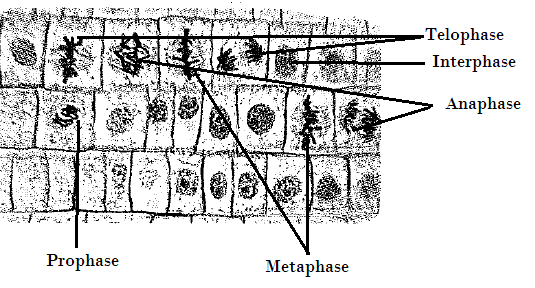
To determine:
The cells that represent interphase, prophase, metaphase, anaphase and telophase.
Introduction :
The cell is the basic unit of life and the series of event that takes place in a living cell during its life is known as the cell cycle. In the last M stage or the mitotic phase of the cell cycle, the cell is divided into two. The mitosis itself is divided into four sub-stages, these are prophase, metaphase, anaphase, and telophase.
Explanation of Solution
The interphase is the phase of cell cycle between two successive division. The G1 phase of the cell cycle is responsible for the growth and promotion of the cell size. The G2 phase occurs after S phase, so, there is no need of
The first phase of the mitotic division is prophase. In the cells, the genetic material is present in an uncoiled manner. So, for the cells division to occur, the DNA (deoxyribonucleic acid) need to be condensed to form a chromosome. In a eukaryotic cell, the prophase starts with condensation of the DNA to form chromosome and the nuclear membrane disappears.
The next phase to prophase is metaphase, at this stage, the condensed chromosomes lie at the equator of the cells. At Anaphase stage, the pull of spindle fibers causes the separation of sister chromatids of chromosomes and leads to the movement of the chromatids to opposite pole. At the end of the anaphase, the movement of the chromatids to opposite pole is completed.
The anaphase is followed by the telophase, which is the last phase of mitosis. After the chromatids reach opposite poles, the nuclear envelope starts developing around it and the chromatids decondense.
Following figure represents the different phases of cell cycle in onion root tip.

Chapter 9 Solutions
Biology Illinois Edition (Glencoe Science)
Additional Science Textbook Solutions
Human Biology: Concepts and Current Issues
Campbell Biology: Concepts & Connections (8th Edition)
Concepts of Genetics (11th Edition)
Human Biology: Concepts and Current Issues (8th Edition)
Anatomy & Physiology (6th Edition)
Microbiology with Diseases by Body System (4th Edition)
 Human Anatomy & Physiology (11th Edition)BiologyISBN:9780134580999Author:Elaine N. Marieb, Katja N. HoehnPublisher:PEARSON
Human Anatomy & Physiology (11th Edition)BiologyISBN:9780134580999Author:Elaine N. Marieb, Katja N. HoehnPublisher:PEARSON Biology 2eBiologyISBN:9781947172517Author:Matthew Douglas, Jung Choi, Mary Ann ClarkPublisher:OpenStax
Biology 2eBiologyISBN:9781947172517Author:Matthew Douglas, Jung Choi, Mary Ann ClarkPublisher:OpenStax Anatomy & PhysiologyBiologyISBN:9781259398629Author:McKinley, Michael P., O'loughlin, Valerie Dean, Bidle, Theresa StouterPublisher:Mcgraw Hill Education,
Anatomy & PhysiologyBiologyISBN:9781259398629Author:McKinley, Michael P., O'loughlin, Valerie Dean, Bidle, Theresa StouterPublisher:Mcgraw Hill Education, Molecular Biology of the Cell (Sixth Edition)BiologyISBN:9780815344322Author:Bruce Alberts, Alexander D. Johnson, Julian Lewis, David Morgan, Martin Raff, Keith Roberts, Peter WalterPublisher:W. W. Norton & Company
Molecular Biology of the Cell (Sixth Edition)BiologyISBN:9780815344322Author:Bruce Alberts, Alexander D. Johnson, Julian Lewis, David Morgan, Martin Raff, Keith Roberts, Peter WalterPublisher:W. W. Norton & Company Laboratory Manual For Human Anatomy & PhysiologyBiologyISBN:9781260159363Author:Martin, Terry R., Prentice-craver, CynthiaPublisher:McGraw-Hill Publishing Co.
Laboratory Manual For Human Anatomy & PhysiologyBiologyISBN:9781260159363Author:Martin, Terry R., Prentice-craver, CynthiaPublisher:McGraw-Hill Publishing Co. Inquiry Into Life (16th Edition)BiologyISBN:9781260231700Author:Sylvia S. Mader, Michael WindelspechtPublisher:McGraw Hill Education
Inquiry Into Life (16th Edition)BiologyISBN:9781260231700Author:Sylvia S. Mader, Michael WindelspechtPublisher:McGraw Hill Education





